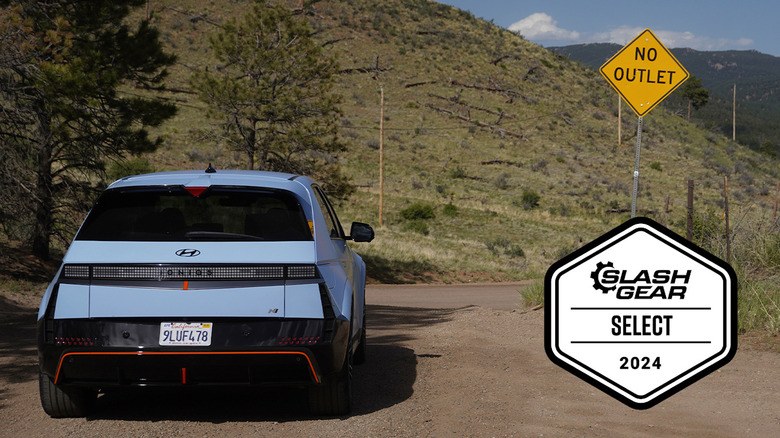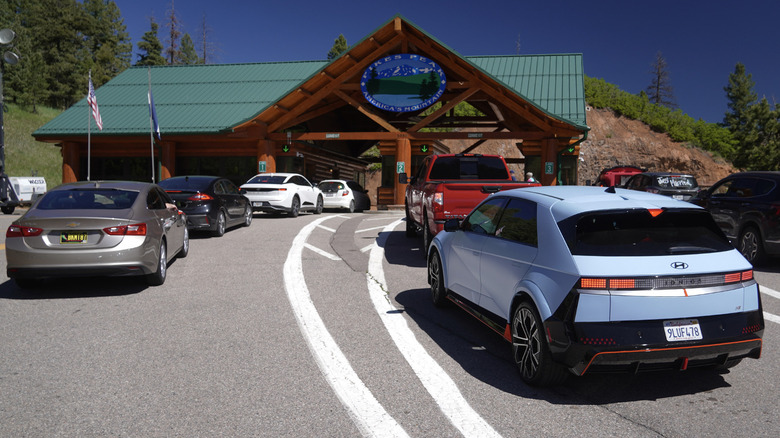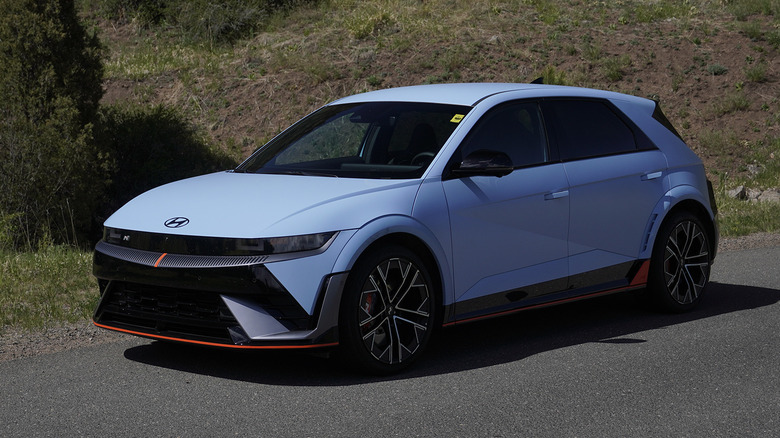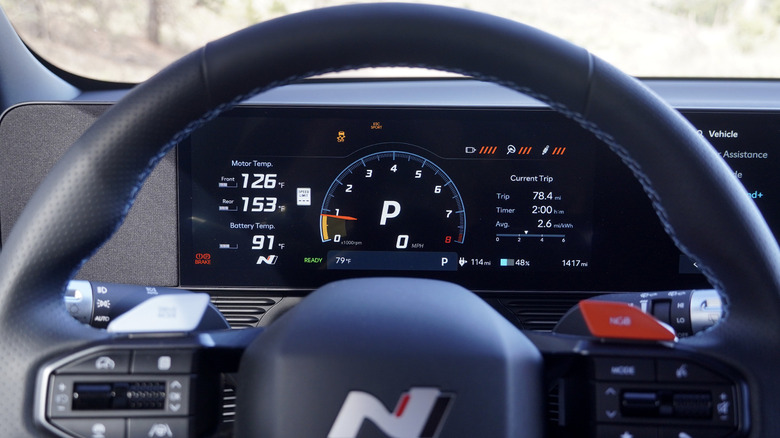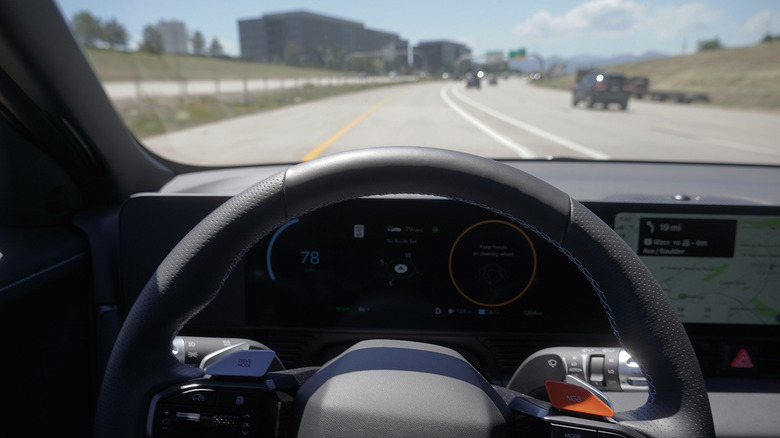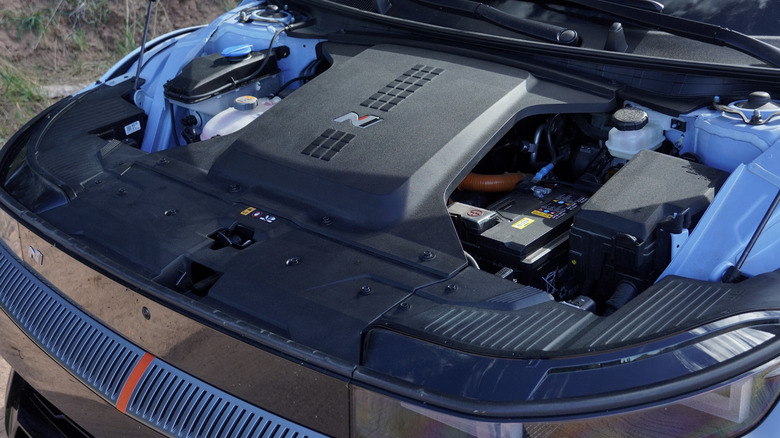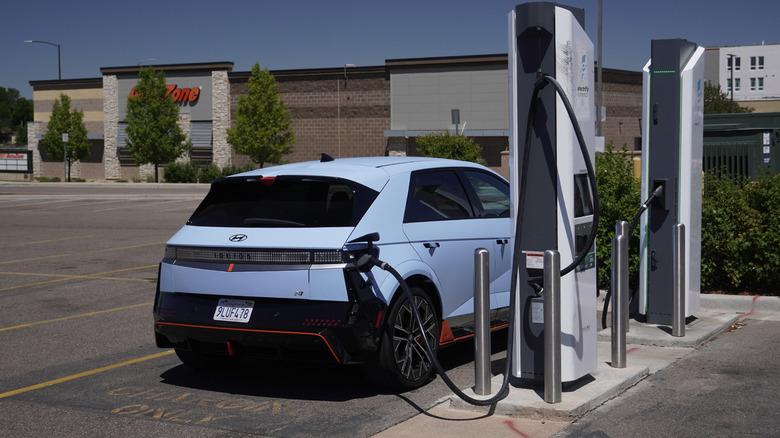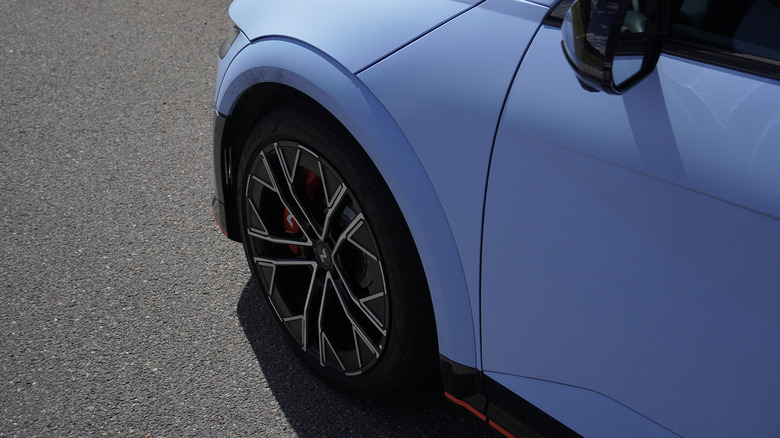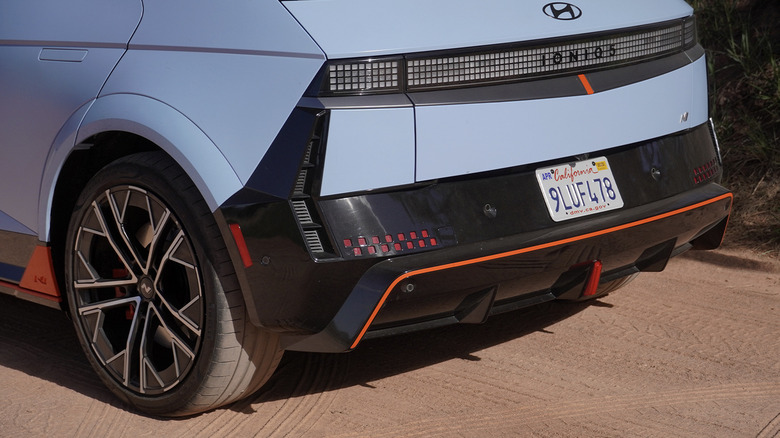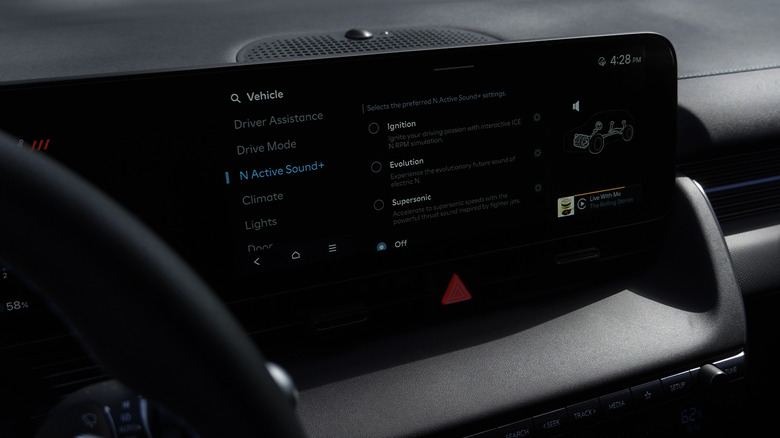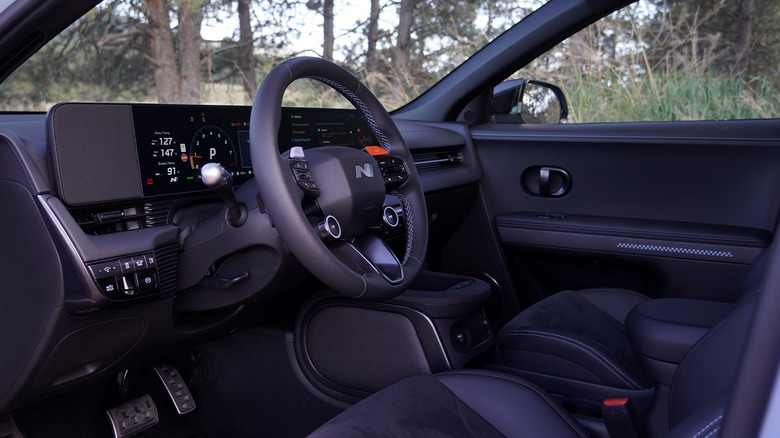2025 Hyundai Ioniq 5 N Review: Living With A Track Star
- The first exciting EV to drive ever
- All the capability of a crossover
- Plenty of customizable drive modes
- Cost escalates into luxury territory without luxurious materials
- Range sacrificed significantly in the name of power
- Fake engine noises and shift points get old quickly
Earlier this spring, I experienced the Ioniq 5 N at a drive program that Hyundai surprisingly held on the track of WeatherTech Raceway Laguna Seca. Laguna Seca's wide corners, long straights, and significant elevation changes proved this new EV's true performance potential, though perhaps not to the extent that a smaller circuit might have revealed. That drive day also included a few minutes of street testing in the hills around Monterey, California where, on the tighter turns of public roads, the I5N revealed an absolutely boisterous personality never before seen from any EV on the market.
A few months later, I took an Ioniq 5 N for a longer loan in Colorado, where I expected the extended trips of daily living to expose perhaps this crossover's biggest drawback: the reduced range that makes such prodigious power output possible in the first place. To do so, I spent four days hustling this Hyundai on highways, city streets, mountain backroads, and all the way up to the summit of Pikes Peak while tracking my state of charge the whole time.
Visiting Pikes Peak in an Ioniq 5 N
I visited Colorado ahead of the official Pikes Peak International Hillclimb, a race that Hyundai officials had announced plans to enter just a few months previously at Laguna Seca. The program included four cars, two in "stock" form with only safety-related modifications, and two far more heavily modified with additional aero, upgraded brakes, racing slicks, and a bit more power output. But of course, I couldn't resist the urge to drive a true production version to the top of the mountain to test how normal driving affects the electric drivetrain over such a steep, winding mountain road.
As at Laguna Seca and Monterey, the I5N's handling stood out for the whole climb, despite the fact that I kept to moderately sane speeds given that the road up Pikes Peak stays open to the general public for almost every day ahead of the race. The steering and suspension simply make driving this EV so much fun, with just enough body roll to communicate exactly how much grip each wheel might (or might not) have while cornering, braking, and accelerating.
Fake sounds, real performance
The controversial soundtrack of the drive, on the other hand, started out somewhat enjoyable but ended up seeming entirely ridiculous only a few miles in. Even climbing upwards of 10% grades, I never particularly wanted to keep pretending that the electric motors reached redline unless I popped a paddle shifter to drop into a "better" gear. The fake engine singing out as if turbocharged provides a disconcerting gap from the instantaneously available torque, too, especially in the setting where gearshifts are no longer necessary.
Then again, electric cars running in the Pikes Peak race need to run loud external speakers, often a bleating siren, as a way of warning spectators, media, and wildlife in a sort of compensation for the actual engine noises of internal-combustion cars. How about just blasting "Freebird" at top volume, instead?
More time to appreciate the I5N
Meanwhile, driving up Pikes Peak provided something of the perfect I5N use case in action, since I hauled two bicycles to the top of the mountain to ride down the stark descent, then attempted the climb using only my own leg power. Here the utilitarian appeal of a larger hatchback profile came into play, as on the base Ioniq 5. Sure, the N modifications include a more heavily bolstered pair of front seats in typical sports car fashion, but the rear seats and cargo area still provide the roominess made possible by compact EV packaging.
Without the strict schedule of that Laguna Seca media drive, my time in Colorado also afforded more opportunities to appreciate some of the I5N's design details. I dug the grids of the head and taillights, while noticing a few more aero details that enhance the sportier aesthetic alongside the fender flares, rear spoiler, and larger wheels. Cheaper piano black plastic for the rear diffuser remains something of a bummer, though, and I'd prefer the overall design more in a dark metallic gray or silver rather than the matte baby blue launch color.
Highway cruising always tests EVs
On the highway, meanwhile, the N-tuned suspension can soften up sufficiently to provide plenty of compliance and an almost sumptuously smooth ride quality. But the N department clearly prioritized weight savings over additional sound insulation, as wind noise and tire hum creep into the cockpit at higher speeds. The performance-focused Pirelli P Zero tires, mounted in place of more eco-conscious rubber, probably contribute to the less peaceful ride.
A quick blast up to Denver also afforded me a chance to test the lane-keeping adaptive cruise control that I never even activated a single time in Monterey (and certainly not on track at Laguna Seca). Hyundai's tech works fairly well, though most automakers can claim the same lately. Only the longest sweepers—very common around Denver—required that I prevent the steering from ping-ponging too close to the sides of lanes, and even sudden slowdowns never seemed to surprise the system.
Starting to think about charging
Of course, I always wonder whether using adaptive cruise or hands-free systems helps to maximize fuel economy on internal-combustion cars or better manage range on electrics. I suspect that, in a true test, I could do better than the robots, yet given the frequent long drives that come as part of the cost of living in Colorado, I still wound up needing to charge twice in four days. The first climb to the top of Pikes Peak at only medium pace used 23% of battery and 42 miles of claimed remaining range to drive just under 19 miles, though in fairness, the route included over 6,500 feet of elevation gain.
Descending from the mountaintop later in the day, I rarely even touched the brakes after ramping up the regen to the maximum setting. In fact, halfway down Pikes Peak, the park rangers operate a brake inspection booth with a laser thermometer, checking the brake rotors of tourists to make sure they won't lose control during the steep descent. My rotors barely rose above ambient air temperature thanks to the electric motors regenerating, which added 13 miles of expected range and seven percent battery charge over another 19 miles or so of downhill.
Charge stats in real-world driving
Next, I drove from Colorado Springs to Pikes Peak International Raceway, about 30 miles south. The I5N performed quite well, using only seven percent battery charge and six miles of range to complete the trip made of mostly highway speeds. At PPIR, I plugged into one of the race team's generator setups to top up the battery, knowing that I needed to get back to Denver in a hurry after watching some racecar testing. Though not a fuel-cell charger as I expected from Hyundai's TCR program, the Pikes Peak team needed the ability to charge up to four racecars at a time during testing both at the raceway and during testing on the mountain. I stayed out watching testing for over an hour, but believe the I5N fully charged to 100% in about 40 minutes—and in this case, a full battery translated to 205 miles of expected range on the gauge cluster.
When I then made a run up to Denver at top speed, often battling a headwind, the range dropped steadily, yet more slowly than the car's onboard computer predicted. I knew that the return trip might drain me down to zero, so after 124 miles I stopped at an Electrify America station in a Walmart parking lot to add a few miles worth of electrons—after all, most EVs can manage the fastest charging rates in the middle zone of battery capacity, and in this case I plugged in with 51% battery and 119 miles of range remaining.
The charge station itself left me frustrated, not least because I struggled to actually locate it in real life versus the map and instructions in EA's app. Not exactly Hyundai's fault, and once plugged in the station maxed out at a solid 220.7 kilowatt charge rate while adding 37.4 kilowatt-hours in just 17 minutes. My battery showed 86% charge and 218 miles of range remaining as I pulled out of the parking lot, which easily lasted me the rest of the journey looping back to Colorado Springs.
The N package defies physics
In an Ioniq 5 N, the choice between cruising in traffic on Interstate 25 or ripping up into the mountains for the return trip to Colorado Springs really isn't much of a choice at all—once my battery readout showed a high enough number to quell my range anxiety. So I skipped the trudgery and returned to the roads where this Hyundai feels more at home, with the suspension firmed up despite gnarly surfaces and the steering dialed into the tightest ratio with reduced assist. Under hard acceleration and while cornering harder than an EV ever should, I ignored the range remaining readout and stuck with the configurable dials showing battery and motor temperature, or even the faux RPM tachometer.
Even the brake-by-wire system provides a fair amount of feedback, though reaching the chatter of ABS in a screamer of an EV that weighs 4,861 pounds takes surprisingly little effort. But otherwise, the N department's magic simply defies physics. Rippling and rutted roads, torn up by winter and logging trucks, never upset the chassis balance despite my selection of the stiffest shock damper mode. Bumps that might leave spines bruised in other sports cars flew by as I carved through the canyons, grinning as I unleashed an outright sprinter in straight lines.
Dreaming of an EV rally racer
With the traction control intervention turned way down, though not quite in full drift mode, a bit of tail wag started to show as my tires warmed up to the exercise and my own confidence grew and grew in this impressive machine. The rear-biased all-wheel drive allowed me to simply countersteer by a few degrees as my fronts worked to compensate for the overzealous rears. For a little while, at least, I started to enjoy the paddle shifting and faux engine noises.
But flipping through various drive modes in the name of science, I remembered that the identical blue buttons on the steering wheel bring up two different gauge cluster tachometer styles—one of which turns off the fake shifting. Now, the instantaneous torque just built and built, without any fake lurching at redline or loss of grunt lower in the rev range. The kind of sheer shove that, in short, makes all the torquey performance electrics so enjoyable in the first place.
A disconnect from reality
And therein lies the Ioniq 5 N's main disconnect from Hyundai's apparent market positioning—other than the pricing and range, anyhow. Buyers who can and will shell out for an EV that starts at $66,100 want that futuristic fun, but do they want the fakery? Sure, I could turn off the sounds and shifts, even select a more ridiculous "Supersonic" setting that combines Starship Enterprise zinging with Top Gun: Maverick fighter jet whine. But the steering and suspension seem to be more of the point here, despite the impressive power output. The playfulness, in short, of an EV that borders on rally racer—and passing by all those dirt roads in rural Colorado left me wishing for some knobby tires, rather than the performance-oriented Pirellis.
That price point makes for a real obstacle in my mind, too, especially considering the I5N's range. Even if that range proved entirely realistic throughout my time in Colorado—air conditioning blasting and highway speeds notwithstanding—a Lucid Air Pure in rear-wheel-drive trim costs about the same and nearly doubles the mileage capability. I love the I5N, but the Air still tops my list of potential EV purchases given the world-beating range but also the impressive powertrain packaging that allows for an unbelievable amount of interior volume (if not quite the same utility as a crossover). At $69,900 and up, the Air also nails a level of premium design and materials that trends toward the luxury customer far more than this big-ticket Hyundai.
A perfect EV for a very specific buyer
Meanwhile, the I5N seems catered more toward owners of Civic Type Rs or GR Corollas. You know, the kind of enthusiasts who love turbo noises and shifting gears—but manually shifted gears, maybe, in the internal-combustion drivetrains of far cheaper cars. That buyer simply isn't the same as the $70,000-plus EV buyer, even if a few early adopters prove exceptions to the rule. Hyundai obviously expects to sell far more base Ioniq 5s than Ns, but I still wonder how many units the latter actually winds up moving in sheer business terms.
Because unlike the Air, jumping into the I5N requires making tradeoffs that my time in Monterey first hinted at and four days in Colorado definitely confirmed. Namely that reduced range, a clearly budget-led interior, and a high price tag take away some of the enjoyment factor while living with an EV that otherwise prioritizes outright speed and enjoyable driving dynamics.
The Hyundai probably caters best to the experienced EV owner. Someone who already left range anxiety in the past and knows how to make the adjustment to a lifestyle of frequent charging, yet still wants to occasionally enjoy all the benefits that the electric revolution already has to offer. For that highly specific niche of buyer, the N department absolutely nailed the brief.
